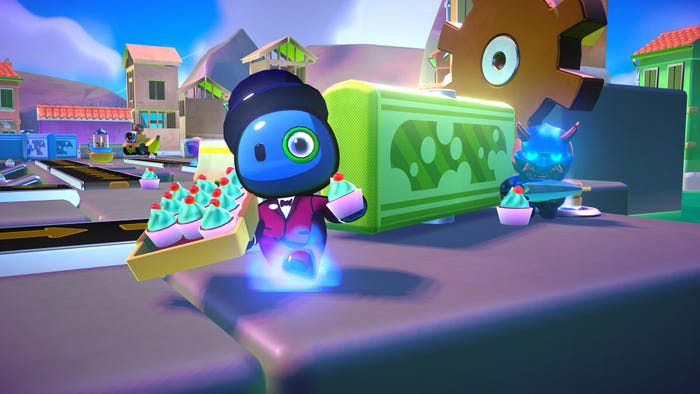Tetsuya Mizuguchi, founder and CEO of Enhance Games and a former game director at Sega, recounted his creative journey toward creating his ground breaking 2001 rhythm game Rez at GDC 2016 today.

Tetsuya Mizuguchi, founder and CEO of Enhance Games and a former game director at Sega, recounted his creative journey toward creating his ground breaking 2001 rhythm game Rez at GDC 2016 today. The game, which will re-release later this year as a PlayStation VR launch title, Rez Infinite, was one of the defining games for the Sega Dreamcast and Sony PlayStation 2. Here is an excerpted transcript of Mizuguchi’s memories of the classic game:
“I want to tell you about some creative serendipities that opened up my senses to creating Rez. In the early 1980s, the arcade game Xevious first opened up my crazy and wild imagination. I wanted to create something off what I was experiencing.
"When I was at university my friend turned me on to the Bitmap Brothers’ Xenon 2 Megablast on the Amiga. This game almost shocked me; it gave me a sense of a new medium, the idea that games as an art-form can exist. I saw the marriage of game, art and music merging and intertwining so well was undiscovered at that time until I met this game. I don’t know that artists could move over to games. It gave me a sense of hope that this could be a new place for artistic experiences.
"I started out my career developing arcade games for Sega. Sega Rally was one of the first projects I worked on. I already had the kernel of an idea for a full body experience, using hydraulic cabinets and so on. Although it was a fuzzy concept, and although the name Rez wasn’t in my head, there was an idea that never left my mind about wanting to one day create a game based around music and sound.
"While working on some of these racing games I had a chance to travel often to Europe. On one of the trips I was led to a Street Parade in Zurich Switzerland in 1997. 300,000 people gathered in the city center for an EDM concert. The techno beats coordinated with the lights and people blew me away. I was an art student so this was an area I’d always been interested in. What I was seeing, and the meaning behind it, perfectly synched in my head.
"A hundred years ago a figure of the Bauhaus movement, Kandinsky, roamed around the streets of Moscow and painted a canvas of the sounds that he saw. He illustrated not only what he saw, but also what he heard throughout the streets and alleyways. Nothing in the human instinct has changed, but back then it was a canvas for him. Fast-forward and we can recreate that same experience on a screen. That’s where another layer of inspiration came to me.
"I had a number of thoughts brewing in my head. The marriage of game and music; Creating music as you shoot down enemies; A game that puts you in a trance; A bodily sensation, whereby vibration mixes with light and sound. Today we have music games as a genre. But in the late 1990s we didn’t have enough of these kids of games to create a new category. We had to do a lot of research.
"We went clubbing (which some of our team members had never done). We went to Taiko drumming festivals. It was all purely research. We’d watch videos of street bands, notice the colors and how it came together and made us feel.
"One video in particular, of some African musicians playing together in the street, was hugely influential. The video starts with silence, then a small beat, then all of these other musicians start joining in in. We watched this video thousands of times, figuring out the architecture of the music. In this way the game design started to form.
"Then we had to think about layering on the sound and the color. The idea was that shooting gives you sounds; it’s like a call and response. We had many types of experiments. The magic that happened is quantization. Even if a player wasn’t great at matching their interactions with the beat, quantization would synch the rhythms of play and make you feel good. When we first made this work it felt like magic. This became the essence of perfecting the game mechanics of Rez, and I carried it through into later projects like Lumines and Child of Eden. It was a long, long journey to get it right, but it was a treasure of a discovery.
"I want to tell you about the game's story. Ostensibly you’re hacking the system, killing viruses, and bringing a network back to normal. But there’s another level that I’ve not talked about before. The underlying story is about life’s journey. Everybody in the world had the same experience; a long time ago you were sperm. We all had the experience of being sperm looking for the egg. It is a metaphor we used and interpreted into game form.
"If you clear the game, we wanted to create a game you’d want to play over and over again, finding new things. Even though I was young at that time, we really squeezed out every ounce of energy and sweat to channel out experiences through the game, to have you play over and over and even learn something from the game.
"What are we, as game-makers, doing in our work? I think game-making is about redesigning our life experiences. Rez was a magical experience that I went through. Fifteen years ago I played Rez at a PlayStation party in Shibuya in 2001. The day before I changed my hair color to silver. I will never forget that day."
Read more about:
event gdcAbout the Author(s)
You May Also Like








